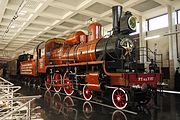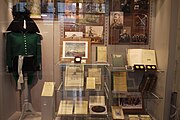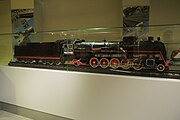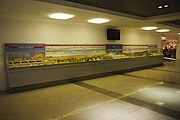
The Railway Museum in Utrecht is the Dutch national railway museum. It was established in 1927 and since 1954 has been housed in the former Maliebaan station.

Paveletsky station is one of Moscow's nine main railway stations. Originally called Saratovsky Railway Station, it was named after the settlement of Pavelets, when the railroad heading south-east from Moscow reached that point in 1899. The ornate building of the station, completed in 1900 and extensively reconstructed in the 1980s, remains one of the biggest Moscow railway stations. In 1924, it was the place where Muscovites came to meet the body of deceased Lenin. The Lenin Funeral Train is still a permanent exhibit at the Museum of the Moscow Railway. The Aeroexpress train links Paveletsky station with Domodedovo Airport. The station is operated by the Moscow Railway.

Varshavsky station, or Warsaw station, is a former passenger railway station in Saint Petersburg, Russia. It is located to the south of the city centre, and was in operation from 1853 to 2001 From 2001 to 2017 it served as the home of the Russian Railway Museum.

A funeral train carries a coffin or coffins (caskets) to a place of interment by railway. Funeral trains today are often reserved for leaders, national heroes, or government officials, as part of a state funeral, but in the past were sometimes the chief means of transporting coffins and mourners to graveyards. Many modern era funeral trains are hauled by operationally restored steam locomotives, due to the more romantic image of the steam train against more modern diesel or electric locomotives, however non-steam powered funeral trains have been used.

Rizhsky station is one of the nine main railway stations in Moscow, Russia. It was built in 1901. As well as being an active station it also houses the Moscow Railway Museum. The station is operated by the Moscow Railway.

The Soviet locomotive class IS was a Soviet passenger steam locomotive type named after Joseph Stalin. The contract design was prepared in 1929 at V.V. Kuybyshev Locomotive Factory in Kolomna, Russian SFSR. The IS series locomotives were manufactured between 1932 and 1942.

TU2 (ТУ2) is a Soviet narrow gauge diesel locomotive for the track gauge of 750 mm

The DRB Class 42 was a type of steam locomotive produced for the Deutsche Reichsbahn. It is one of the three main classes of the so-called war locomotives (Kriegslokomotiven), the other two being class 50 and 52.
The Baldwin 0-6-6-0 1000/1 DE is a cab unit diesel-electric locomotive built by Baldwin Locomotive Works in 1945. The 0-6-6-0 1000/1 DEs were powered by an eight-cylinder diesel engine rated at 1,000 horsepower (746 kW), and rode on a pair of three-axle trucks in a C-C wheel arrangement. 30 of these models were built for Soviet Railways, today Russian Railways, as Class Дб.

The Russian steam locomotive class O was an early type of Russian steam locomotives. Between 1890 and 1928, 9129 locomotives were built; hence it was the second most numerous class of locomotive in Russia, after E class, which was a unique number even on the international level.

The Soviet locomotive class FD was a Soviet main freight steam locomotive type named after Felix Dzerzhinsky. Between 1932 and 1942, 3213 FD series locomotives were built.

The Russian locomotive class Ye, and subclasses Yea, Yek, Yel, Yef, Yem, Yemv and Yes were a series of 2-10-0 locomotives built by American builders for the Russian railways in World War I and again in World War II. They were lightweight engines with relatively low axle loadings.

The ChS7 Russian: ЧС7 is an electric mainline DC passenger locomotive used in Russia and Ukraine. The locomotive consists of two sections and was produced in years 1983 to 1999 at Skoda's V.I. Lenin plant in Plzen, Czech Republic. It was specially developed for the railways of Soviet Union with later models procured by Russian and Ukrainian operators. Along with ChS8, the Chs7 is one of the most powerful electric locomotives used in the countries of the former USSR.

The Russian locomotive class U was a Russian express passenger steam locomotive type. The class U was a 4-6-0 four-cylinder compound locomotive which used de Glehn compound system.

The Russian steam locomotive class Izhitsa (Ѵ) was a steam locomotive produced in Russia and the Soviet Union between 1908 and 1918, and between 1927 and 1931. The Russian letter Ѵ can be transliterated as Hy. On Russian and Soviet railways, these were the most powerful steam locomotives of type 0-8-0. They were designed by E. E. Noltein and had a 16-ton axle load.

Russian steam locomotive U-127 is a 4-6-0 locomotive of type Russian locomotive class U, preserved at the Museum of the Moscow Railway next to Paveletsky Rail Terminal in Moscow. The locomotive was the first Russian steam locomotive preserved.

The Soviet locomotive class LV was a Soviet main freight steam locomotive type. Between 1952 and 1956, 522 locomotives were built.

The Soviet locomotive class P36 was a Soviet mainline passenger steam locomotive type. Between 1950 and 1956, 251 locomotives were built. The locomotives were nicknamed "Generals" because of the red stripe down the side. The P36 had the same power as a class IS locomotive but the axle loading of 18 tons allowed its use on the vast majority of Russian railway lines, replacing class Su 2-6-2s and significantly increasing the weight of passenger trains. The P36 was the last type of mainline steam locomotive built in the Russian SFSR and the last one built, P36-0251, was the last steam locomotive produced by Kolomna Works, Russian SFSR. Though sometimes described as the "Victory" type locomotive, that moniker actually belongs to the class L 2-10-0 built between 1945 and 1947.

The Museum of North Caucasus Railway is a railway museum in Rostov-on-Don, Rostov oblast, Russia, which opened on 1 August 2003. It consists of a room in a Community Center of railwaymen and a display area 12,400 m² at Glubokaya halt on the south-west outskirts of Rostov-on-Don.

The Russian Railway Museum is situated next to Baltiysky railway station in Saint Petersburg. The museum was established in 1978, its current site and exhibition opened to public on 1 November 2017. The museum utilizes the nineteenth century locomotive shed of the Peterhof Railway built in 1857–1858, however a large second exhibition building and open exhibition areas have been added.



























